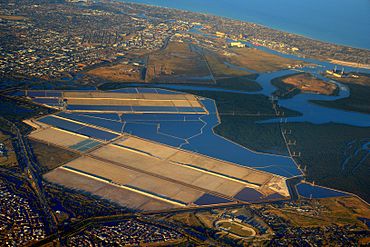Gillman, South Australia facts for kids
Quick facts for kids GillmanAdelaide, South Australia |
|||||||||||||||
|---|---|---|---|---|---|---|---|---|---|---|---|---|---|---|---|

Aerial view of Gillman and surrounding areas
|
|||||||||||||||
| Postcode(s) | 5013 | ||||||||||||||
| LGA(s) | City of Port Adelaide Enfield | ||||||||||||||
| State electorate(s) | Port Adelaide | ||||||||||||||
| Federal Division(s) | Hindmarsh | ||||||||||||||
|
|||||||||||||||
| Footnotes | Adjoining suburbs | ||||||||||||||
Gillman is a suburb in the north-western part of Adelaide, Australia. It's mostly an industrial area, meaning it has many factories and businesses. Gillman is part of the City of Port Adelaide Enfield. It also sits within the federal area known as the Division of Hindmarsh and the state area called the electoral district of Port Adelaide.
Contents
Gillman's Railway History
Gillman was once a very important place for trains. It had large railway yards where train carriages were sorted and moved. These yards were part of the Dry Creek–Port Adelaide railway line, which was built in 1868. This line helped connect the area to the Port Dock railway station.
Over time, more railway connections were added. In 1915, a new track called the Rosewater Loop was built. This connected the Dry Creek line to the Outer Harbor railway line. It also led to a new Port Adelaide railway station and a bridge over the Port River.
In 1982, the train tracks in Gillman were updated. They were changed from "broad gauge" (a wider track) to "dual gauge." This meant the tracks could be used by trains with different wheel widths. This was part of a bigger project to update the Adelaide–Port Augusta railway line.
The large Gillman railway yards closed down in the early 1990s. After that, the Rosewater Loop became the main train line. In 2008, the Rosewater Loop itself closed. The main line then moved to a new path, crossing the Port River over the Mary MacKillop Bridge.
The Multi-Function Polis Idea
In the late 1980s and early 1990s, Gillman was chosen for a big project called the Multifunction Polis (MFP). This was a joint idea between the Australian and Japanese Governments.
The MFP was meant to be a special area focused on high-tech industries and new technology. It was planned to have its own rules, similar to "Special Economic Zones" in other parts of the world. These zones are places where businesses get special benefits to encourage growth.
However, the MFP project faced many challenges. There were protests from local people. Also, there was disagreement about working with Japan on such a large project. Because of these issues, the MFP plan did not go ahead in Gillman. Instead, the ideas from the MFP were later used to create places like Technology Park Adelaide and Mawson Lakes nearby.
Motorsport Excitement
Gillman has been a key spot for Motorcycle Speedway racing in Adelaide for many years. Speedway is a type of motorcycle racing on an oval dirt track.
The first track, called North Arm Speedway, opened in 1981. It was 280 metres (920 ft) long and located on the Grand Trunkway. This speedway operated until 1997 when it had to close.
Since 1998, Gillman has been home to an even bigger speedway venue. The Gillman Speedway is 300 metres (980 ft) long and is located on Wilkins Road. It continues to be a popular place for motorcycle speedway events.
Historical Explosives Storage
From 1858 to 1906, Gillman was home to the North Arm Powder Magazine. A "powder magazine" is a very secure building used to store explosives. This facility was used to keep dangerous materials like dynamite and gelignite safe.


